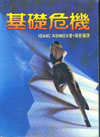It is 498 years since the establishment of the First Foundation. The threat of the Mule has been rebuffed; on Trantor it is a period of calm and prosperity. But an unexpected appearance by psychohistorian Hari Seldon raises some interesting questions and the young Councilman who asks them finds himself exiled into space in search of answers: Does the Second Foundation still exist? And does it continue to control human history from a secret Galactic refuge? At issue—the destiny of humankind.
FOUNDATION’S EDGE is the most eagerly anticipated science fiction novel of our time. It is the first science fiction novel from the Master in a decade—a stirring blend of actions and ideas with future technology and hyperspace travel. The sequel to The Foundation Trilogy has all the wisdom, humor, and intrigue that have made its predecessors the most widely read science fiction series of all time. Asimov has done his classic threesome one better.
In some respects, this is the most important of all the Foundation books. After putting the series behind him in 1950, Asimov was finally coerced into writing a new Foundation novel by Doubleday in the mid-1980’s. Foundation’s Edge is, in fact, the first actual Foundation novel.
Its success startled Asimov—for the first time, he had a book that made the best-seller lists—and he was delighted. It did well enough, in fact, that Doubleday was able to convince Asimov to do further continuations of the Foundation series and (at long last) the third Elijah Baley novel.
In terms of the series’ conception, this is an important book as well, in two respects.
The first is that Asimov decided to bring his robot and Foundation books together. There had always been a certain overlap in terms of technology—blasters, neuronic whips, and hyperspacial Jumps—but never any explicit connection. Indeed, robots were conspicuously absent from the Foundation books. For people like me who grew up reading the earlier books, the most natural explanation was that they were in fact separate fictional universes. Nor were these the only ones—the Multivac stories of the 1950’s occupied yet a third, and there were miscellaneous others in other stories.
Asimov, however, made the decision that his two major universes should be one, and set out to begin the explanation in Foundation’s Edge of why we see no robots on Terminus. This first connection between the two series is fairly faint and not at all intrusive. In some sense, in fact, it is virtually irrelevant to the plot. Personally, I didn’t see any need for it, but neither did it bother me much.
At the same time, Asimov needed something to drive the action and that something was going to be yet another threat to the Seldon Plan. He had done this once before with ”The Mule,” forty years earlier, and he did it again. By rewriting the Mule’s past somewhat, he was able to create a planet of Mules, Gaia. Gaia also represents the kind of world-organism Asimov had objected to in “Green Patches,” here, however, made the ideal destiny of mankind.
The less than ideal destinies of mankind are represented by the two Foundations. The Mayor of Terminus is a Susan Calvin clone; the (future) First Speaker from Trantor is an overambitious fop. Between them stands the person of Golan Trevieze, who has the uncanny knack for knowing what is right at any given time—and at the end of the book, he decides for some reason not even he fathoms that Gaia is right, and that mankind’s future should be a super-Gaia, Galaxia.
There are a number of levels at which this book can be discussed. On the whole, I was very pleased with it. The characters are not all terribly interesting. The two female characters, the Mayor of Terminus, and Bliss, a young Gaian woman (robot?) are Asimovian stereotypes we have seen before. The other main characters are reasonably well-drawn but, as I say, not terribly interesting. This is probably the book’s main weakness, and the main reason to rank it below the first three Foundation books.
More interesting is Asimov’s increased sophistication in handling the Galaxy. Different regions are shown to have their own dialects, local ideas and customs intrude, superstition dominates a part of the book. The Second Foundation is shown to be run by human beings, who can be just as petty and uninspiring as anybody else.
This is definitely one of the stronger Foundation books, probably the best of the last four. It opens up the door to new possibilities for the Foundation’s universe and represents new hope for Asimov as a science fiction writer.


